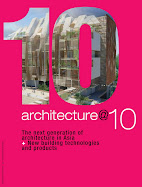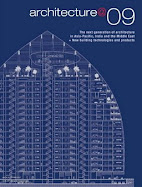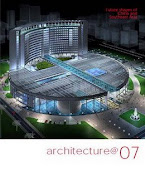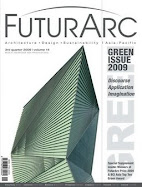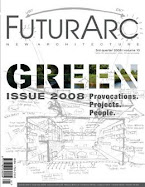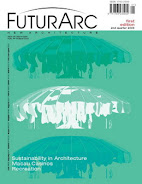FuturArc Prize for green building design
International Design Competition for Green Architecture 
Architectural professionals and students are invited to enter the FuturArc Prize 2009 international design competition for green buildings. The competition, organized by FuturArc journal, is sponsored by Autodesk and supported by the World Green Building Council, UNEP Sustainable Buildings and Construction Initiative as well as architectural and green-building institutions in Southeast Asia and Hong Kong.
This year's competition offers entrants a choice of two project briefs. The first is contributed by an Indonesia developer seeking for an Office Building + Urban Park, on an actual site in West Jakarta. The second is a Community Hub, one that is imagined for a Greener future, for which entrants must select a site from in the city/region they reside. The design submissions must address form, space and activity in a manner innovative and appropriate for the brief, site and climate. The Jury will be looking at how green strategies, systems and technologies are integrated in an imaginative manner, resulting in a user-centric architecture that is functional and in sync with social and cultural demands of their context.
Entries can be submitted online at www.futurarc.com/prize by 31 December 2008. Winners will be notified on 31 March 2009, then receive their awards as well as total cash prizes of SGD33.000 in subsequent prize-giving ceremonies. Entry in the competition is free.
Winning entries will be determined by an international jury of green building experts. The jury consists of Dr Nirmal Kishnani of the National University Singapore, Dr Ray Cole of the University of Columbia, Kevin Hydes of the World Green Building Council, Professor Kazuo Iwamura of the Musahi Institute of Technology, Dr Stephen Siu Yu Lau of the University of Hong Kong and Dr Deo Prasad of the University of New South Wales.
Dr Kishnani, the jury’s chair, said, “The FuturArc Prize has quickly become the preeminent platform for Green aspirations in the region. Last year, the numbers were strong; the submissions innovative and varied. This year, in the second year of the competition, we hope for more than a bigger turnout; we are on the look out for ideas that inspire and clarify what it means to be a Green in this part of the world.”
Design innovation software leader Autodesk is supporting this event in an important way by providing complimentary copies of its Revit Architecture software for Building Information Modeling (BIM) to registered entrants for use in the competition.
“Green design is an increasingly crucial reality for practitioners in the architecture, engineering, and construction industry,” explained Emmanuel Samuel, Autodesk’s Director for Sales Development for Architecture, Engineering and Construction (AEC) in the Asia Pacific “Autodesk firmly believes that ‘green design’, or global sustainability challenges, can be addressed through better design. To this end, the company is focused on making sure its design products enable sustainable design more readily, powerfully and accurately, and while actively partnering with industry leaders and educators such as FuturArc to promote awareness and adoption of sustainable design practices.”
About the jury
Nirmal Kishnani, PhD, is the Chief Editor of the FuturArc Journal. He is both an educator and practitioner in the area of Green buildings, presently teaching at the Department of Architecture of the National University of Singapore. He has lectured and written widely on the subject of Greening in Asia and has been a consultant to projects across the region, most recently as head of a sustainability unit operating from Singapore. Dr. Kishnani is Jury Chair of FuturArc Prize 2009.
Ray Cole, PhD, is the Director of the School of Architecture and Landscape Architecture at the University of British Columbia and Academic Director of the School's Design Center for Sustainability. Dr Cole was selected as a North American Association of Collegiate Schools of Architecture Distinguished Professor for "sustained commitment to building environmental research and teaching" in 2001. In 2003 he received the Architectural Institute of British Columbia Barbara Dalrymple Memorial Award for Community Service and the US Green Building Council's Green Public Service Leadership Award.
Kevin Hydes, is the Chair of the World Green Building Council and Vice President of Stantec Consulting Engineers. He served as Chair of the USGBC for 2005-2006, and is a founder and director of CanadaGBC. Hailing from Leeds in the UK, Kevin has focused on green design for the past 15 years. His vision led to the first LEED Gold Certified project in Canada, the first LEED-EB Gold Certified project in North America, and the successful completion of 20 LEED Certified projects with more than 30 registered projects awaiting certification. He is an Honorary Member of the Royal Institute of Canada and the Architectural of BC, and an adjunct professor at McGill University School of Architecture.
Kazuo Iwamura, M.E. is a Professor in the Faculty of Environment and Information studies at the Musashi Institute of Technology in Yokohama Japan and CEO of IWAMURA Atelier Co., Ltd. He is also Chair of ARCASIA's Committee for Green & Sustainable Architecture, UIA Councillor of Region IV (Asia + Oceania), Director of the UIA Work Programme Architecture for a Sustainable Future and a member of the board of the World Green Building Council.
Stephen Siu Yu Lau, PhD, is a Professor of the School of Architecture at the University of Hong Kong. He served as Chairman of the Faculty Board of Architecture in 2006, and is the Associate Dean from 1998–2006. Graduated from the Barlett School of Architecture in London, Stephen focuses on building science and sustainable environment. He is currently a member of the International Initiative of Building Environment iiSBE based in Ottawa, Canada, and has published more than 30 academic journal papers and several books.
Deo Prasad, PhD, is the Director of the Sustainable Development Program at the University of New South Wales. He has worked on milestone projects including Australia's first solar village, scientific validation of computer simulation tools for energy performance prediction of buildings and related green building assessment tools, advanced performance simulation of buildings using complex modelling software and the Green Olympics projects. He has won an Australian National Innovation Award and the NSW Government 2004 Green Globe Award.
About the prize
The FuturArc Prize has been established by the BCI Group of Companies through its FuturArc journal to inspire architects and other building professionals to draft innovative designs for Green buildings on sites in Asia-Pacific. The Competition format encourages participants to work as integrated teams in producing holistic Green building solutions. Publicity surrounding the Competition is intended to promote competency in Green building design as well as the importance of Green buildings for the environment.
About the promoter
FuturArc Journal is the Competition Organizer whose intent is to promote green building in Southeast Asia, Australia and China. Published by the BCI Group, FuturArc is a quarterly journal recognising the significant impact of the buildings on society and the environment. FuturArc advocates architecture that demonstrates creativity, social responsibility and sustainability. For more information, visit www.futurarc.com.



